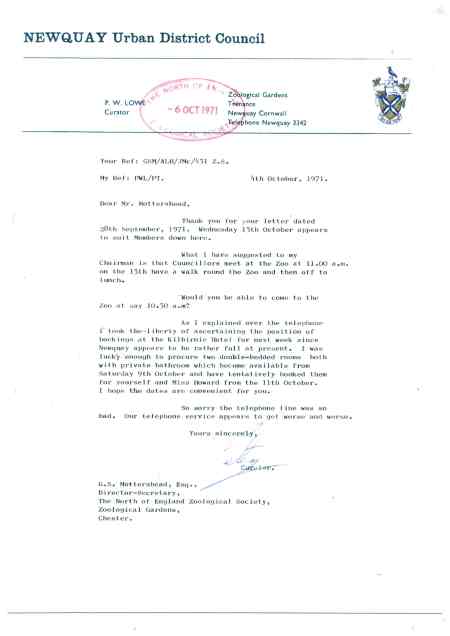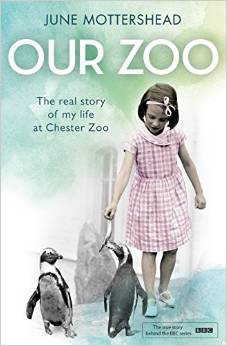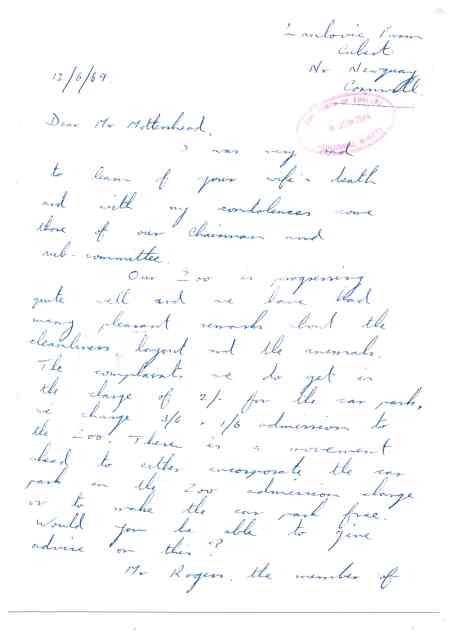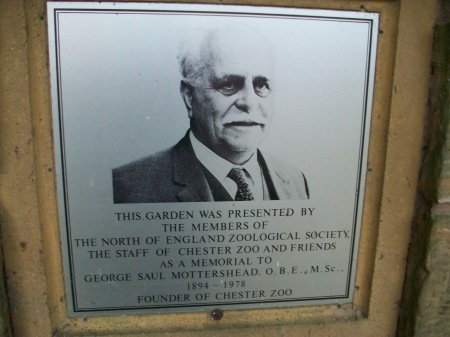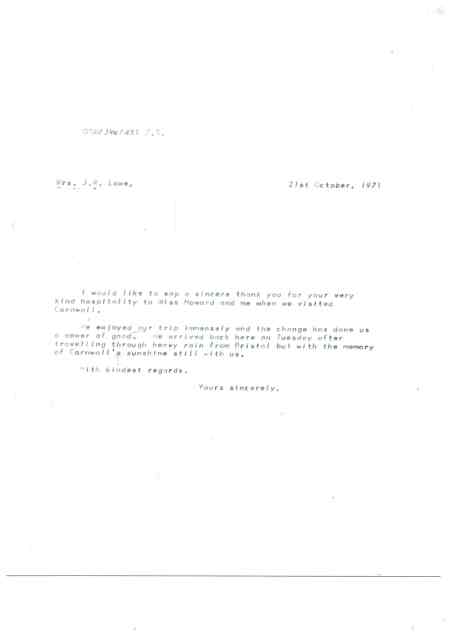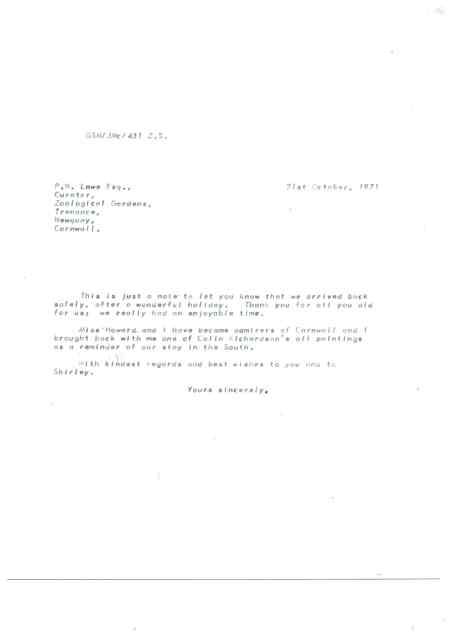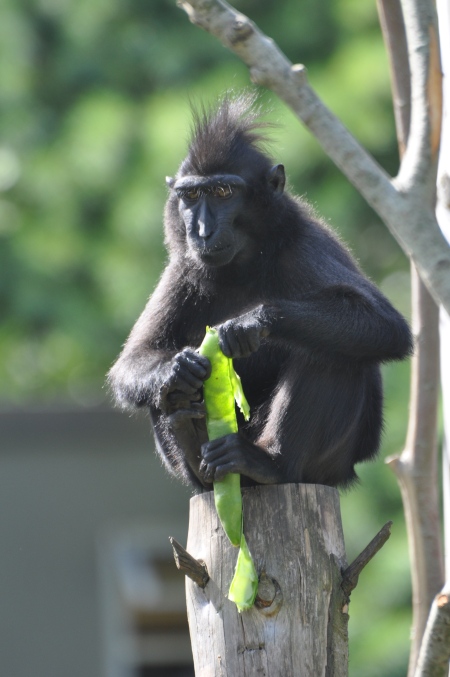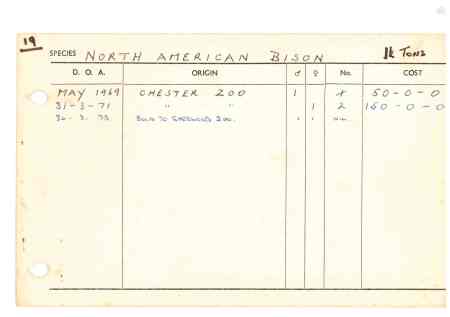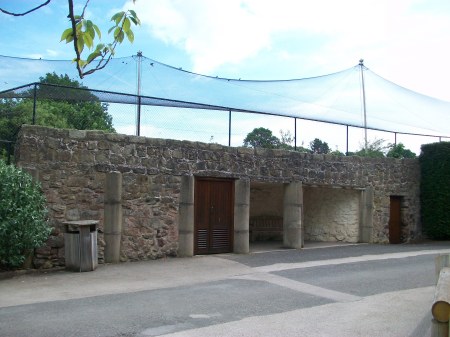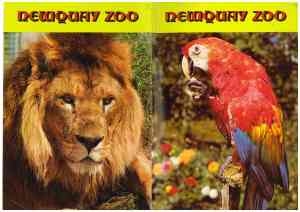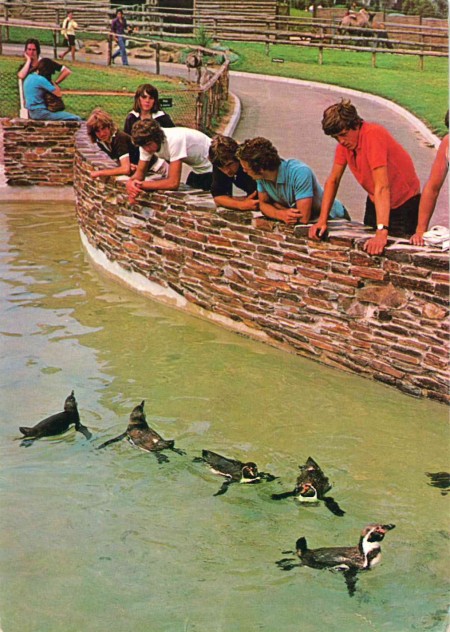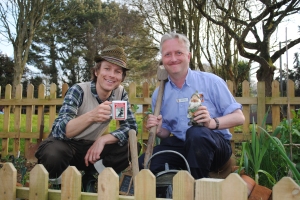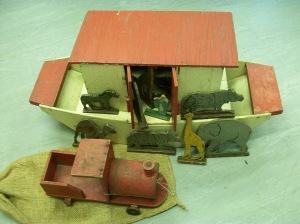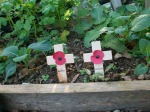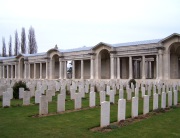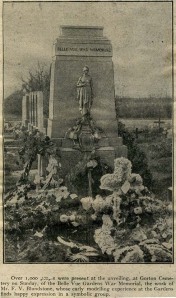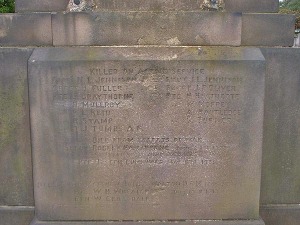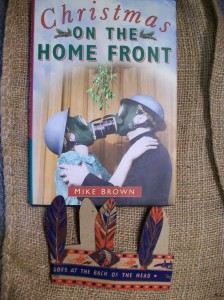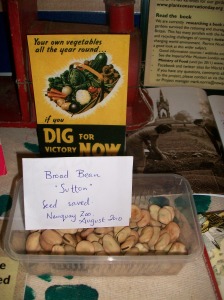
Somme poppies, Thiepval area, France taken on my first trenches tour, 1992 (Copyright: Mark Norris)
The 1st July 1916 was the opening day of the Battle of the Somme, arguably one of the worst days in the history of the British Army.
Experts remain divided over whether Haig’s battle plans and The Somme Battles overall were a complete disaster or a sharp learning curve for his “Citizen Army” of volunteers.
Amongst these “Pals” battalions of early volunteers from similar streets, towns or trades were several Zoo and Botanic gardens staff, some of whom were killed or wounded. They joined the memorial and roll of honour list of scientists, museum staff, gardeners and naturalists that we have been following as part of the World War Zoo Gardens project to see what impact WW1 had on zoos, botanic gardens and similar trades and institutions.

Several British zoo staff with no known grave are remembered on the Thiepval Memorial to the missing of the Somme battles.
(Image: CWGC website)
‘The Zoo’ ZSL London Zoo
10.07.1916 Albert A Dermott 13th Btn. Rifle Brigade, Rifleman ZSL Messenger
Rifleman S/4504 Albert Arthur Dermott, 13th Btn. Rifle Brigade, (The Prince Consort’s Own) ZSL Messenger, aged 22, was killed on the Somme and has no known grave, being listed on the Thiepval Memorial.
Dermott is listed amongst the 72,000 names on the strangely shaped Thiepval memorial to the missing dead who have no known grave of the Somme battles of 1916-18. The memorial by Lutyens which sits high on a hill overlooking the killing fields of France is nicknamed by some the ‘elephant’, with its howdah or passengers on a zoo elephant ride.
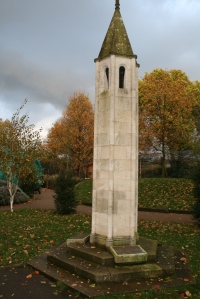
Autumn colours behind the ZSL war memorial, London Zoo, November 2010 (Photo: Kate Oliver, ZSL Education)
According to CWGC records, Albert Arthur Dermott was the son of Frederick John Dermott and (Margaret) Rachel Frances Dermott (nee Creswell) of 2 Queen’s Road, Dalston, Middlesex, London. After his mother Rachel’s death, Dermott’s father Frederick remarried a Louisa Archer.
Albert was born in Islington, Middlesex, London on 25th April 1894 and was resident and enlisted in Marylebone, Middlesex. According to his medal records, he entered service overseas on 29 July 1915 (earning a 1915 star) and was killed just under a year later. He would have been only just past 22 years old when he was killed in action.
Dermott is listed on the Thiepval project database. The following biographical information was researched by Ken and Pam Linge for Dermott’s database entry, culled from Census information – Dermott was the youngest of five children. His siblings were Rachel Margaret Dermott (b.1883), Alice Louisa Dermott (b. 1885), Frederick John Dermott (b.1887), Edith Dermott (b. 1891). The young Albert was educated at Shap Street School, Hackney from 9th September 1901.
15.9.1916 Arthur G Whybrow 2547, 19 Bn. County of London Regt , ZSL Helper.
Whybrow joined up on 4 September 1914 and went to France on 8th March 1915. He was killed during the Somme battles, probably in the clearance of High Wood by 47th (London) Division, 15 September 1916.
Born around 1891, Arthur Whybrow worked first as a Domestic Gardener (like his father John) before joining London Zoo as a keeper (noted on his marriage certificate in July 1913). He married Daisy Sutliff and they had a child, Winifred Daisy Whybrow born 1913/14. Daisy remarried after Arthur’s death, a Mr Goodard in mid 1919.
High Wood was fiercely fought over during the Battle of the Somme until cleared by 47th (London) Division on 15 September 1916 when Whybrow was killed. The original ‘London’ Cemetery at High Wood was begun when 47 men of the 47th Division were buried in a large shell hole on 18 and 21 September 1916. Other burials were added later, mainly of officers and men of the 47th Division who died like Arthur Whybrow on 15 September 1916. His gravestone looks slightly more squeezed in next to others than normal as if this is a mass grave.
A G Whybrow lies buried with many others of his London Regiment who died on the same day.
At the Armistice in 1918 Whybrow’s cemetery contained 101 graves. The cemetery was then greatly enlarged when remains were brought in from the surrounding battlefields, but the original battlefield cemetery of London Regiment soldiers where Whybrow is buried is preserved intact within the larger cemetery, now know as the London Cemetery and Extension. The cemetery, one of five in the immediate vicinity of Longueval which together contain more than 15,000 graves, is the third largest cemetery on the Somme with 3,873 First World War burials, 3,114 of them unidentified.
Listed on CWGC website as the son of John and Louisa Whybrow, of Hampstead, London and husband of Daisy Goodard (formerly Whybrow), of 193, Junction Rd., Highgate, London.
05.10.1916 Gerald P Patterson 19th County of London Regt ZSL Helper
The 19 County of London Regiment may be an error or his first regiment. This is likely to be 43689 Private Gerald Phillips Patterson of the 8th Battalion, Norfolk Regiment was killed on 5th October 1916 during the Somme fighting. He is buried in an individual grave XI. C. 4. in Connaught Cemetery, Thiepval, Somme, France. There is no family inscription on his headstone, pictured on the TWGPP website. .
The life of his battalion during the Somme battles is well set out in the Somme school visit site http://www.schoolhistory.co.uk/forum/index.php?app=core&module=attach§ion=attach&attach_id=2956
It is likely that Patterson went into action with the Norfolks on the 1st of July 1916, the first day of the Somme as part of the 18th (Eastern) Division as part of K2, Kitchener’s 2nd Army Group of New Army volunteers. Patterson was most likely killed during the attack and capture of the Schwaben Redoubt on the 5th October 1916. The next day his battalion went back for rest out of the line.
Many of Patterson’s 8th Norfolk battalion who were killed and whose bodies or graves were not found are remembered on the nearby Thiepval Memorial, alongside other ZSL staff like Albert Dermott.
Patterson is listed on the ZSL memorial plaque as 19th County of London Regiment; along with several other ZSL staff he enlisted locally in Camden Town, Middlesex, close to the London Zoo.
Later he must have transferred to his County regiment the Norfolks as he was born in Great Yarmouth like his parents and siblings. His father was a school attendance officer and Patterson was the youngest of 7 brothers and sisters, all born in Great Yarmouth. On leaving school, the 1911 census lists him as an Auctioneer’s Articled Pupil, before becoming a ZSL Helper (a junior or trainee keeper rank).
There are now 1,268 Commonwealth servicemen of the First World War buried or commemorated in the Connaught cemetery. The vast majority of the burials are those of officers and men who died in the summer and autumn of 1916 battles of the Somme. Half of the burials are unidentified, many brought in from smaller cemeteries around the Somme battlefields area.

William Dexter, ZSL London Zoo keeper killed in WW1
(Photo: Courtesy of Nova Jones, digital clean up Adrian Taylor ZSL)
23.10.1916 William Dexter Kings Royal Rifles, Rifleman ZSL Keeper
Rifleman S/19841 William Dexter was a married keeper enlisted in the 2nd Battalion, Rifle Brigade, The Prince Consort’s Own, who died on or around 23 October 1916 aged 31. Dexter is buried in an individual grave XVIII. J. 5. at Bienvillers Cemetery, near Arras,and the Ancre, France.

Nova Jones, Dexter’s granddaughter, inspects his name on the new panels at the ZSL London Zoo staff war memorial. (Image: Mark Norris)
According to his granddaughter Nova Jones whom I met at London Zoo in March 2014, William Dexter came from a zoo family of several generations. The daughter of William’s daughter Dora, Nova found in time for ZSL’s wartime centenary exhibition in 2014 a photograph of William Dexter in uniform with Rifles cap badge and has confirmed with the Royal Greenjackets Museum that “William as a Rifleman (Service no. S/19841) served with the 2nd Bn. Rifle Brigade (The Prince Consort’s Own) during the First World War.”
William Dexter was listed on his Army Medical Form as a “Keeper at Zoo”, 5 foot 5 ½ inches, Physical development ‘Good’. His father Robert Dexter had been employed at the zoo from the 1860s onwards. After working as a labourer and painter, William obtained employment ‘as worth keeping’ in 1908, rising to Junior Keeper of Ostriches in 1913 before joining up. The 31-year-old father of four children, enlisted in the Rifle Brigade in December 1915.
A portion of boot with his numbering appears to be all that helped identify William Dexter and prevent him being buried like all the others as “Unknown British Soldier”.
After barely one month serving in France he was listed as “Missing – accepted as having died on or since 23 October 1916”. Although war service and pension records are difficult sometimes to decipher, “A portion of boot” was seemingly all that was left to identify his missing body , along with posthumous medals and a pension, for official recognition and return by the authorities of Keeper Dexter to his wife and four children.
Belle Vue Zoo Manchester
Belle Vue Zoo staff 1916 deaths
3. Private William Morrey 27 June 1916
Several William Morreys from the Cheshire, Lancashire and Manchester area are listed on the cwgc.org site, obviously a local name.
Before his enlistment under the Derby Scheme, it appears our William was the one who worked as a water and gas fitter at the Zoological Gardens at Belle Vue, Manchester.
Pioneer 130519 William Morrey died aged 21 on the 27 June, 1916, serving originally with the Manchester Regiment but on his death with the 1st Battalion of the Special Brigade, Royal Engineers (a gas unit).
William Morrey is buried in the middle of the second to back row of these hospital related casualties, Beauval Communal Cemetery, Somme, France.
Morrey is buried at an individual grave B17 at Beauval Communal Cemetery, Somme, France. The great majority of the burials were carried out from such hospitals as the 4th Casualty Clearing Station where Morrey died at Beauval from June 1915 to October 1916.
Directly alongside Morrey in three other graves B 14-16 are three others of this special Battalion killed on the same day, Pioneer 129027 Richard Brown, Pioneer 128027 James Duckett (also from Manchester) and Pioneer 128805 Walter Norman Welton.
CWGC lists Morrey as the son of William and Lydia Morrey, of Widnes. Mr A.E. Morrey of 13 Ollier Street, Widnes, Lancs appears to have chosen the family inscription on his CWGC headstone: “He gave his life for Freedom”
Morrey and comrades lie in the middle of the second to back row of Beauval Cemetery, France. Image: cwgc.org
These Special Companies are described on the Long, Long Trail website http://www.1914-1918.net/specialcoyre.htm and on their forum posts #61 Royal Engineers Special Brigade: post #61 jones75 which gives the following information:
Pioneer William Morrey, No.130519, 21st Section, 1st Bn, Special Brigade, Royal Engineers
Born : Widnes, Lancashire.
Enlisted : Manchester, 20th January, 1916.
Resided : The Lodge, Halton View, Widnes.
Died of wounds in France on 27th June, 1916, aged 21.
Buried at Beauval Communal Cemetery, Row B, Grave 17.
William Morrey is also commemorated at St Ambrose church in Halton View, the Belle Vue Zoo memorial and on the Widnes War Memorial in Victoria Park, Widnes in Cheshire.
William Morrey was the second son of William & Lydia Morrey and died in No.4 Casualty Clearing Station on the 27th June as result of gas poisoning on the previous day.
His sister, Mrs Dutton of Milton Road, Widnes, received a letter from an Army Chaplain, Reverend H.D.W. Dennison, CF, in it he wrote….
”It is with deep regret that I have to tell you of the death of your brother, Pioneer W. Morrey. He was admitted into this hospital yesterday afternoon suffering severely from gas poisoning, and though everything possible was done for him, he died early this morning. I am burying him this afternoon with four of his comrades who suffered the same fate in Beauval Cemetery. May he rest in peace and, and may God comfort sad hearts that his loss will cause……”
An old boy of Simms Cross school, William Morrey also attended St Ambrose church and Sunday School and was a member of the Gymnasium at St Paul`s Parochial Rooms. On leaving school, he worked for five years as an apprentice gas & water fitter at the Corporation Gas Works in Widnes.
Before his enlistment under the Derby Scheme he worked as a fitter at the Zoological Gardens at Belle Vue, Manchester.
He joined up on 20th January, 1916 into the 14th Bn, The Manchester Regiment, regimental number 32486 and in March that same year was transferred to the Royal Engineers and sent to France.
He wrote his last letter home in mid June and in it he said he was in the best of health and expected to be moved nearer to the front line. (WWN 1916)
The Special Brigade, Royal Engineers was a unit formed to counter the German Gas threat, they were employed to dispense poison gas from the allied trenches towards the enemies lines, it is possible that William Morrey was gassed carrying out this task as accidents and the effect of shell-fire on the equipment caused leaks on a regular basis.
So Morrey died in the preparation for the Somme, which three months later would claim another Belle Vue Zoo colleague, Alfred Routledge.
Routledge is one of several British zoo staff with no known grave who are remembered on the Thiepval Memorial.
4. Private Alfred Routledge
He died serving with the 11th Battalion Manchester Regiment on The Somme aged 23 on 26 September 1916. He was killed in an attack on Mouquet Farm which was part of the final and successful British attempt to capture the village of Thiepval.
The village occupied high ground in the centre of the battlefield and had been a British objective on the first day of The Battle of The Somme on 1 July 1916.
Alfred Routledge is one of the many “Missing of the Somme” listed on the Thiepval memorial, having no known grave. Routledge was killed in the final days of taking Thiepval village, one of the original objectives of the 1st July 1916, the first disastrous day of the Battle of The Somme two months earlier.
CWGC lists him as the son of the late Alfred and Emily Barton Routledge of 504 Gorton Lane, Gorton. Married.
Routledge and fellow Belle Vue Zoo staff Sidney Turner and Ralph Stamp are remembered on the St. James Parish Church war memorial http://gortonphilipsparkcemetrywargrave.weebly.com/st-james-church-gorton.html
Chester Zoo
George Mottershead who founded Chester Zoo in 1930s was badly wounded on the Somme on 15 October 1916. The Mottersheads were nurserymen and market gardeners, as shown in BBC Our Zoo June Mottershead’s ‘Grandad’ Mottershead working well into old age and wartime to provide food for his son’s zoo animals. Three of June’s Mottershead uncles and step-uncles from this gardening family were killed in the First World War, two others on her mother’s side, whilst her father George was badly wounded on theSomme.
Kew Gardens
Royal Botanic Gardens Kew wartime casualties 1916
Several Kew staff were killed serving in the Somme area later in the autumn of 1916.
https://worldwarzoogardener1939.wordpress.com/2013/07/19/such-is-the-price-of-empire-the-lost-gardeners-of-kew-in-the-first-world-war/
Sydney George Cobbold, 3 October 1916.
Sergeant Sydney George Cobbold, S/12906, 8th Battalion, Rifle Brigade died on the 3rd October 1916, aged 28. His 1917 Kew Guild Journal obituary lists from his letters back to Kew that he had enlisted in the Rifle Brigade by June 1915 and shortly after November 1915 embarked for France.
He is buried at Grave Reference II. B. 7, Le Fermont Military Cemetery, Rivière, a front line cemetery of 80 burials begun by the 55th (West Lancashire) Division in March 1916 and closed in March 1917. Looking at the Graves Registration GRU documents, it appears that on the same day that Sgt Cobbold was killed, 4 other 8th Rifle Brigade were killed and buried in the same plot 2 Row B of this front line cemetery alongside him – Rifleman L.J. Farr, W.G. Kittle, Benjamin Gordon (Jewish star in place of a cross) and fellow sergeant J.R. Aspden, Military Medal. Cobbold lies among his comrades and his men.

Sydney Cobbold of the 8th Battalion, Rifle Brigade died 3rd October 1916, Somme area (Kew Guild photo)
John Divers, 9 October 1916
Rifleman John Divers, service number 7056, 1st / 9th Battalion, London Regiment (Queen Victoria Rifles) and also County of London Cyclists, died on 9th October 1916 when his patrol into No Man’s Land towards the German trenches was wiped out. For a time he was “missing, believed killed” and an officer wrote to his father that they had not been “able to thoroughly search the ground” for his body.
As a result Divers has no known grave and is one of two Kew Gardens casualties (with H.M. Woolley) listed amongst the missing of the Somme Battles on the Thiepval Memorial at Panel Reference Pier and Face 9 C. John Divers is listed amongst over 72,000 men from the UK and South Africa who died in the Somme area before March 1918 and who have no known grave. An excellent Thiepval database exists to put faces to names and add to the publicaly available knowledge about these 72,000 men.
Several Kew staff with no known grave are remembered on the Thiepval Memorial
At the end of September 1916, Thiepval village was finally captured from the Germans, one of the original objectives of the disastrous first day of the Battle of The Somme on 1st July, 1916. Attacks north and east continued throughout October when John Divers was killed and into 18th November in increasingly difficult winter weather. Over 90% of those commemorated on the Thiepval Memorial died like John Divers between July and November 1916.
Having visited this Thiepval memorial, it is like many of the other memorials to the missing such as the Ypres Menin Gate, quite overwhelming to scan the panels ccontaining thousands of carved names.
Born 7 August 1891 at Redhill in Surrey, he was the only son of a gardener and amateur botanist Mr Jos. Jas. Divers. From a well known family of gardeners, Divers worked with his uncle W.H. Divers VMH at Belvoir Castle, Grantham before joining Kew, March 1912, quickly becoming a Sub-foreman, Herbaceous and Alpine Dept. He was killed on the same day as fellow Kewite H.M. Woolley. (Thanks to his relatives for some of this background family / genealogical information).

John Divers, Kew Gardens
Herbert Martin Woolley, 9 October 1916
Listed on the Kew memorial as Rifleman / Corporal Herbert Martin Woolley, “Essex Regiment” is most likely to be Rifleman 3844, 1st / 5th Battalion, London Regiment (London Rifle Brigade), died 9 October 1916. Herbert is commemorated on Panel Reference Pier and Face 9 D, Thiepval Memorial, along with fellow Kewite John Divers.
Born 27 September 1883, Herbert was the son of G.H. Woolley, Vicar of Old Riffhams, Danbury, Essex. In 1908 after working in several nurseries and Kew 1906-08 he left to work managing a rubber estate in North Borneo. He returned from Borneo to join the Essex Regiment but ditched his commission and training as an officer to become a corporal in the London Rifle Brigade to see action more quickly. His brother suggest he was also promoted to Sergeant. Herbert was killed shortly after the attack on Combles in 1916.
Herbert or “Bertie” Woolley came from a high-achieving and distinguished family of 12 children including his brother Lieutenant Colonel Sir Charles Woolley (1880 – 1960), “Woolley of Ur”,a famous archaeologist who knew Lawrence of Arabia. His brother Major George Harold Woolley VC OBE MC (1892 – 1968) was the first Territorial to win the Victoria Cross. In G.H. Woolley’s autobigraphy, “Sometime a Soldier“, Bertie’s unusual decision to become a private soldier and change regiments to get to the front quicker is described:
“While I was on sick leave my third brother, Bertie, returned from British North Borneo. He had been trained at Kew Gardens and in Germany, and then was employed on rubber plantations in Borneo. When in England he had joined the old Militia, so I had no difficulty in helping him to get a commission in the Essex Regiment. He soon tired of England, so transferred as a private to the London Rifle Brigade; he did well with them in France and was quickly made a sergeant, then offered a commission. He was killed with the L.R.B. on the Somme in 1916.
G.H. Woolley, Sometimes A Soldier. London: Ernest Benn, Ltd., 1963, pp. 38-39
Charles Henry Anderson, Albert Medal, 29 November 1916
Lance (or Lance Corporal) Charles Henry Anderson died on 29/11/1916 aged 26, Service no. 2326, 1st/14th Bn. London Regiment (London Scottish). His medal record card states that in addition to the standard Victory and British war medals, he was also awarded the Albert Medal (citation below). Anderson is buried amongst 253 WW1 Commonwealth soldier burials at Grave Reference II. K. 3, St. Venant Communal Cemetery in France. From 1915 to 1917 this cemetery was linked to British and Indian forces Casualty Clearing Stations in the area.
His mother Mrs L. Anderson chose the inscription on his headstone: “I Will Give Unto Every One of You According to His Works” (Revelation 2.23)
” The King has been graciously pleased to award the Decoration of the Albert Medal of the First Class in recognition of the gallantry of Lce. Cpl. Charles Henry Anderson, late of the 1st/14th Bn. of the London Regt., who lost his life in France in November last in saving the lives of others. On the 28th Nov., 1916, Lce. Cpl. Anderson was in a hut in France with eleven other men when, accidentally, the safety pin was withdrawn from a bomb.
In the semi-darkness he shouted a warning to the men, rushed to the door, and endeavoured to open it so as to throw the bomb into a field. Failing to do this, when he judged that the five seconds during which the fuse was timed to burn had elapsed, he held the bomb as close to his body as possible with both hands in order to screen the other men in the hut. Anderson himself and one other man were mortally wounded by the explosion, and five men were injured. The remaining five escaped unhurt. Anderson sacrificed his life to save his comrades.”

Royal Botanic Gardens Edinburgh no doubt had staff who served during the Somme Battles but they lost no staff there. Their equivalent to the Loss of Pals battalions on the Somme was the loss of several staff in the local regiment 5th Royal Scots at Gallipoli in 1915.
Gardeners and others
Garden magazine editor, writer and Kewite Herbert Cowley was home from the trenches, invalided out and newly married by 1916.
His new brother in law was killed on the first day of Battle of the Somme, as his wife Elsie Mabel (nee Hurst) lost her 30 year old brother Percy, a clerk.
Rifleman 4278 Percy Haslewood (or Hazlewood) Hurst of the 1st /16th Battalion, London Regiment (Queen’s Westminster Rifles) waskilled on the 1st July 1916, during his battalion’s diversionary attack on Gommecourt. Percy left a wife Geraldine of 18 Teddington Park, Middlesex. His widowed clerk / accountant father Samuel and typist sister Elsie Mabel was left grieving for his loss.
Like Herbert’s Kewite colleagues Rifleman John Divers and Corporal Herbert Martin Woolley, Percy H. Hurst is listed on the Thiepval memorial to the Missing of The Somme (Pier / face 13C). Several other Kew Gardens staff are listed in the Kew Guild magazine ‘Roll of Honour’ section as serving in Percy Hurst’s local London Regiment but thankfully survived.
https://worldwarzoogardener1939.wordpress.com/2013/03/22/dig-for-victory-1917-world-war-1-style-the-lost-gardeners-of-kew-and-the-fortunate-herbert-cowley-1885-1967/
Wartime editions gardening magazines and journals listed lost gardeners such as George Harrow, son of George Harrow of Veitch’s Nursery, killed 1st July 1916. Gardener T. Percy Peed, a nurseryman, died serving with the 8th South Staffs in France on 10 July 1916.
Gardener Sergeant L.A. Iceton Seaforth Highlanders died on 26 July 1916.
RHS Wisley lost several staff during the Somme Battle period including:
Private John Fletcher Lee 31st Battalion Canadian Infantry, died 5 July 1916, buried at Lijssentheok Cemetery.
2nd Lieutenant Fritz Bowyer, 9 Squadron RFC died on 25 July 1916, Arras a Flying Services Memorial.
https://www.rhs.org.uk/education-learning/blogs/libraries/August-2014/First-World-War-commemoration-at-Wisley
Natural History / British Museum staff
Private C.R. Dunt, killed Hebuterne, on staff of British Museum
Scientists, naturalists and others
Of the eight fellows FLS of the Linnean Society casualties lost in WW1, two were lost in the Somme period and battles of 1916.
Geoffrey Watkins Smith 10 July 1916
A Captain in the 13th Battalion Rifle Brigade, Geoffrey Watkins Smith died on 10 July 1916 is buried in grave III J 27, Pozieres British Cemetery, Ovillers la Boisselle. CWGC lists him as the son of Horace and Susan Eleanor Penelope Smith, of Beckenham, Kent. A Fellow of New College Oxford, Watkins Smith wrote several books including Primitive Animals and A Naturalist In Tasmania.
Wilfrid Omer Cooper 26 September 1916
Born 1895, he was killed in 26 September 1916. He had been involved with the Bournemouth Natural Science Society, studying isopods. Elected to the Linnean Society only in Spring 1915, he was still a private G/40113 in the 12 Battalion Regiment, Middlesex Regiment when he died aged 21. He has no known grave and is remembered on the Thiepval Memorial to the missing of the Somme battles.
Wilfrid Omer Cooper has no known grave and is remembered on the Thiepval Memorial.
He is listed on the CWGC website as the son of the late John Omer Cooper (died 1912) and Mrs. Mary Elizabeth Thompson Cooper, 6 Queensland Road, Boscombe, Bournemouth. On the listing for Soldiers Died in The Great War (SDGW) he is listed as born at Boscombe, Bournemouth, Hants and resident at Bournemouth. He enlisted at High Beech, Loughton and was originally listed as formerly B/23290 Royal Fusiliers.
In 1911 census he and his brother Joseph Omer Cooper were both schoolboys living with their 89-year-old father (a retired auctioneer, surveyor and estate agent, born in Reading, Berkshire 1822-1912) and 53-year-old mother Mary (born Willenhall, Staffordshire, 1858-1944) at 50 Westley Road, Boscombe. Two other children had not survived infancy. His brother Joseph served from 1914-19 in Britain in the Royal Army Medical Corps (RAMC).
He may be the author of several books including The Fishing Village and other writings (Literary and Scientific) posthumously published in Bournemouth by H.G.Commin 1917, the author one Wilfrid Omer-Cooper.
https://worldwarzoogardener1939.wordpress.com/2013/09/11/lost-fellows-the-linnean-society-roll-of-honour-1914-1918/
Remembered all as part of #Somme100
Posted on 1st July 2016 by Mark Norris, World War Zoo Gardens Project, Newquay Zoo.









